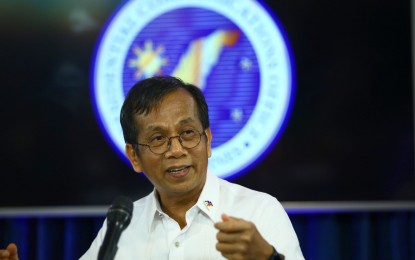
REDUCING POVERTY. National Economic and Development Authority Secretary Arsenio Balisacan says on Friday (Dec. 22, 2023) the government is committed to bringing down the poverty rate to single-digit by 2028. As of the first half of 2023, the poverty rate was at 22.3 percent. (PNA file photo)
MANILA – The country's poverty rate went down to 22.4 percent in the first half of the year from 23.7 percent in the same period in 2021.
In a briefing on Friday, Philippine Statistics Authority Undersecretary and National Statistician Dennis Mapa said this is equivalent to 25.24 million Filipinos whose per capita income is not sufficient to meet their basic food and non-food needs.
This is down from 2021's estimate of 26.14 million poor Filipinos.
Mapa said that on the average, a family of five members will need at least PHP13,797 per month to meet their minimum basic food and non-food needs in the first semester of 2023.
On the other hand, subsistence incidence among Filipinos or the proportion of Filipinos whose income is not enough to buy even the basic food needs was registered at 8.7 percent or about 9.79 million Filipinos.
Across the country, poverty incidence decreased in 15 out of the 17 regions from 2021 to 2023, declining significantly in the National Capital Region, Cordillera Administrative Region, Cagayan Valley, Central Luzon, Soccsksargen, and Caraga.
On the average, the monthly food threshold for a family of five in the same period was estimated at PHP9,550.
Among families, the first semester 2023 poverty incidence was estimated at 16.4 percent, which was equivalent to 4.51 million poor families.
Meanwhile, the subsistence incidence among families went down to 5.9 percent in 2023 from 7.1 percent in 2021 or about 1.62 million food poor families.
National Economic and Development Authority (NEDA) Secretary Arsenio Balisacan said the recent poverty data shows that the government is on track to reduce the poverty rate to single-digit.
"When President Ferdinand R. Marcos Jr. began his term, we aspired for an ambitious goal of reducing poverty incidence to a single-digit level by 2028," Balisacan said.
He said the full reopening of the economy allowed the country to recover from the impact of the coronavirus disease 2019 pandemic.
Balisacan noted that the Philippine economy grew by 5.5 percent in the first three quarters of 2023, making the country one of the best-performing economies in Asia.
Unemployment rate dropped to 4.2 percent in October this year while the underemployment rate also went down to 11.7 percent.
Balisacan said efforts to tame inflation and manage its effects also yielded significant results.
"Government interventions, such as the Targeted Cash Transfer Program, fuel subsidy, one-time rice allowance, and the Libreng Sakay Program, helped mitigate the adverse effects of inflation on poor households," he said.
He admitted, however, that the elevated inflation in the first semester partially offset the positive effect on income growth on poverty.
"We note that per capita income among those in the first income decile (the poorest 10 percent of our population) increased by 21.4 percent, and those in the second and third deciles increased by 19.4 and 18.3 percent, respectively," he said.
Balisacan said if the inflation rate for the bottom 30 percent settled at 4 percent in 2021 and another 4 percent in 2022, the cumulative increase in poverty threshold would be around 8.2 percent instead of 14.2 percent.
"Assuming the same increase in income, poverty incidence among the population would have been about 16 percent instead of the observed 22.4 percent," he said.
Gov’t interventions
Balisacan assured that the government remains focused on its priority to substantially reduce poverty to a single-digit level.
He said the government will ensure the effective implementation of various initiatives and interventions in the social sector to reduce poverty,
"These include the effective implementation of the new Social Protection Floor that institutionalized basic social security guarantees, the passage of the Trabaho Para sa Bayan Act and the Pambansang Pabahay para sa Pilipino Program, as well as the establishment of the Walang Gutom 2027 Food Stamp Program," Balisacan said.
He added that the administration will continue to prioritize creating high quality and high paying jobs to address the rising issue of vulnerable employment.
To achieve this goal, Balisacan said the government will continue to focus on attracting job-generating investments from the private sector, significantly improve human capital, and scale up social and physical infrastructure to improve people's employment prospects.
He said the government will also ensure that macroeconomic fundamentals are sound to sustain growth.
"Lastly, we will continue facilitating policy initiatives to create an enabling environment for investments, trade, and innovation," Balisacan said. (PNA)
